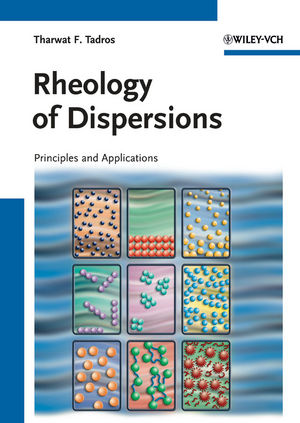Rheology of Dispersions: Principles and ApplicationsISBN: 978-3-527-32003-5
Hardcover
216 pages
November 2010
 This is a Print-on-Demand title. It will be printed specifically to fill your order. Please allow an additional 15-20 days delivery time. The book is not returnable.
|
||||||
Preface
GENERAL INTRODUCTION
INTERPARTICLE INTERACTIONS AND THEIR COMBINATION
Hard-Sphere Interaction
?Soft? or Electrostatic Interaction
Steric Interaction
van der Waals Attractions
Combination of Interaction Forces
Flocculation of Dispersions, and Its Prevention
Distinction between ?Dilute?, ?Concentrated?, and ?Solid? Dispersions
States of Suspension on Standing
States of the Emulsion on Standing
PRINCIPLES OF STEADY-STATE MEASUREMENTS
Strain Rate of Shear Rate
Types of Rheological Behavior in Simple Shear
Time Effects During Flow: Thixotropy and Negative (or Anti-) Thixotropy
Rheopexy
Turbulent Flow
Effect of Temperature
Measurement of Viscosity as a Function of Shear Rate: The Steady-State Regime
Non-Newtonians
Major Precautions with Concentric Cylinder Viscometers
PRINCIPLES OF VISCOELASTIC BEHAVIOR
Introduction
The Deborah Number
Strain Relaxation after the Sudden Application of Stress (Creep)
Analysis of Creep Crves
The Berger Model (Maxwell + Kelvin)
Creep Procedure
Stress Relaxation after Sudden Application of Strain
Dynamic (Oscillatory) Techniques
RHEOLOGY OF SUSPENSIONS
Introduction
The Einstein Equation
The Bachelor Equation
Rheology of Concentrated Suspensions
Rheology of Hard-Sphere Suspensions
Rheology of Systems with ?Soft? or Electrostatic Interaction
Rheology of Sterically Stabilized Dispersions
Rheology of Flocculated Suspensions
Models for the Interpretation of Rheological Results
RHEOLOGY OF EMULSIONS
Introduction
Interfacial Rheology
Bulk Rheology of Emulsions
RHEOLOGY MODIFIERS, THICKENERS, AND GELS
Introduction
Classification of Thickeners and Gels
Definition of a ?Gel?
Rheological Behavior of a ?Gel?
Classification of Gels
Rheology Modifiers Based on Surfactant Systems
USE OF RHEOLOGICAL MEASUREMENTS FOR ASSESSMENT AND PREDICTION OF THE LONG-TERM PHYSICAL STABILITY OF FORMULATIONS (CREAMING AND SEDIMENTATION)
Introduction
Sedimentation of Suspensions
Assessment and Prediction of Flocculation Using Rheological Techniques
Assessment and Prediction of Emulsion Coalescence Using Rheological Techniques
GENERAL INTRODUCTION
INTERPARTICLE INTERACTIONS AND THEIR COMBINATION
Hard-Sphere Interaction
?Soft? or Electrostatic Interaction
Steric Interaction
van der Waals Attractions
Combination of Interaction Forces
Flocculation of Dispersions, and Its Prevention
Distinction between ?Dilute?, ?Concentrated?, and ?Solid? Dispersions
States of Suspension on Standing
States of the Emulsion on Standing
PRINCIPLES OF STEADY-STATE MEASUREMENTS
Strain Rate of Shear Rate
Types of Rheological Behavior in Simple Shear
Time Effects During Flow: Thixotropy and Negative (or Anti-) Thixotropy
Rheopexy
Turbulent Flow
Effect of Temperature
Measurement of Viscosity as a Function of Shear Rate: The Steady-State Regime
Non-Newtonians
Major Precautions with Concentric Cylinder Viscometers
PRINCIPLES OF VISCOELASTIC BEHAVIOR
Introduction
The Deborah Number
Strain Relaxation after the Sudden Application of Stress (Creep)
Analysis of Creep Crves
The Berger Model (Maxwell + Kelvin)
Creep Procedure
Stress Relaxation after Sudden Application of Strain
Dynamic (Oscillatory) Techniques
RHEOLOGY OF SUSPENSIONS
Introduction
The Einstein Equation
The Bachelor Equation
Rheology of Concentrated Suspensions
Rheology of Hard-Sphere Suspensions
Rheology of Systems with ?Soft? or Electrostatic Interaction
Rheology of Sterically Stabilized Dispersions
Rheology of Flocculated Suspensions
Models for the Interpretation of Rheological Results
RHEOLOGY OF EMULSIONS
Introduction
Interfacial Rheology
Bulk Rheology of Emulsions
RHEOLOGY MODIFIERS, THICKENERS, AND GELS
Introduction
Classification of Thickeners and Gels
Definition of a ?Gel?
Rheological Behavior of a ?Gel?
Classification of Gels
Rheology Modifiers Based on Surfactant Systems
USE OF RHEOLOGICAL MEASUREMENTS FOR ASSESSMENT AND PREDICTION OF THE LONG-TERM PHYSICAL STABILITY OF FORMULATIONS (CREAMING AND SEDIMENTATION)
Introduction
Sedimentation of Suspensions
Assessment and Prediction of Flocculation Using Rheological Techniques
Assessment and Prediction of Emulsion Coalescence Using Rheological Techniques



